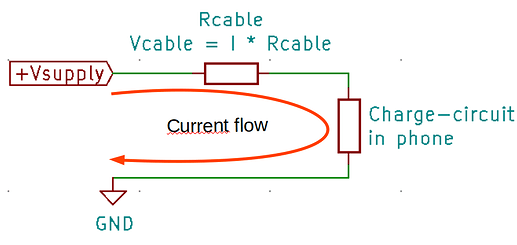To see what’s going on, let’s look at a simplified model. The power supply (the USB wallwart) will “offer” a voltage to whatever load is connected. This is normally 5V. The load, in this case the charger (inside the phone) and the battery, will draw some current I from the power supply. The supply will regulate its output to 5V regardless of the current.
Before you apply Ohm’s Law, you need to consider cable resistance, Rcable:
The same current flows through the power supply, the cable, and the load. So there’s a voltage drop over the cable and an associated power loss as heat: I * I * Rcable = I²*Rcable.
As you can see, the output voltage of the supply doesn’t matter for the cable loss. But output voltage plays a role for output power (and thus power delivered to the battery). Here, you trade higher voltage for lower current.
So, charging at 5V and high current means more heat in the cables. For cheap cables, only intended to carry data signals, enough current will eventually turn the cable into a (blown) fuse…
Also consider Kirchhoff’s Law: Vsupply - Vcable = Vload. High current in thin wires means lower voltage at the load, quite possibly violating the 5V spec. Not so much a problem for the charge circuit, but processors, memory, etc may suffer. (There’s normally a down-converter for the lower supply voltage of these chips.)
Raising the voltage deals with the thin wires, but there won’t be a happy end if an unsuspecting device is subjected to 18V. So there has to be some signalling to make this safe, and the device has to be built such that it can cope with a wide range of input voltages. It’s likely that charge-circuit efficiency will suffer to some degree.
Conclusion
If the cable can sustain 3A without damage, then you can transfer 15W @ 5V, or 54W @ 18V. The cable loss will be the same in both cases, but @ 18V there will probably be additional heat loss in the charge circuit. However, this loss is nowhere near the 39W power transfer gained.
[This attempt at an explanation disregards supply and device negotiating use of additional wires in the cable, or other some clever trick. I’m guessing the quick-charge standards employ every means they can, a bit like Power-Over-Ethernet.]
 thanks!
thanks! ).
).
